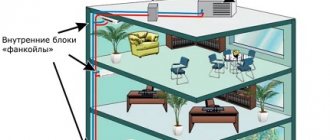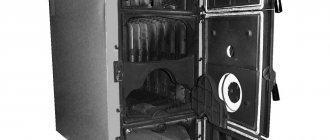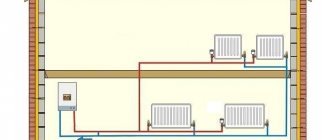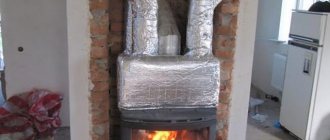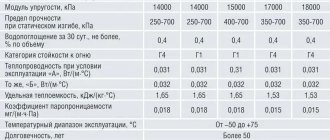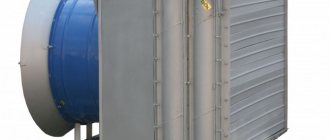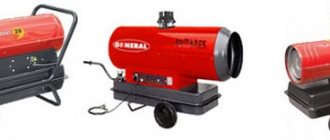Engineering systems › Heating › What kind of facility do you have?
EuroHolod provides heating for production premises with turnkey installation. For questions related to heating, call +7(495) 745-01-41.
To receive a commercial offer
, send a request to [email protected] or submit a quick request.
During the cold season, autonomous heating of the production premises provides the company's employees with comfortable working conditions. Normalization of temperature conditions also has a beneficial effect on the safety of buildings, machines and equipment. Heating systems, although they have the same task, have technological differences. Some use hot water boilers to heat industrial premises, while others use compact heaters. Let's consider the specifics of industrial heating and the effectiveness of using various systems.
Requirements for heating industrial premises
At low temperatures, heating of production premises, as required by labor protection, should be carried out in cases where the time workers spend there exceeds 2 hours. The only exceptions are premises in which permanent presence of people is not necessary (for example, rarely visited warehouses). Also, structures are not heated, being inside of which is equivalent to carrying out work outside the building. However, even here it is necessary to provide for the presence of special devices for heating workers.
Occupational safety imposes a number of sanitary and hygienic requirements for heating industrial premises:
- heating indoor air to a comfortable temperature;
- the ability to regulate the temperature due to the amount of heat generated;
- inadmissibility of air pollution with harmful gases and unpleasant odors (especially for stove heating of industrial premises);
- the desirability of combining the heating process with ventilation;
- ensuring fire and explosion safety;
- reliability of the heating system during operation and ease of repair.
Composition and principle of action
When heating large areas, you need to use more powerful equipment.
Air heating is a heat generator or water heater that heats the air, and a system of branched air ducts designed to transport air flows to heated areas of a workshop or warehouse.
Inside production premises, heated air is distributed due to the operation of fans or distribution heads that direct air flows in the required direction.
Industrial air heating can be presented in the form of a mobile option for heating local areas of the workshop - portable heat guns that successfully perform the task of quickly heating certain areas.
Air recirculation additionally solves the issues of compliance of air parameters in the serviced or working area of production premises with sanitary and hygienic requirements and standards.
Advantages and disadvantages
Air heating of industrial and warehouse premises has a number of competitive advantages over other heating system designs:
- High efficiency (up to 93%), absence of intermediate links (pipes, radiators, etc.).
- Maintaining a constant level of microclimate inside production premises due to the possibility of integrating climate and heating systems.
- Low inertia, allowing the premises to be heated to the required level in a short period of time.
- Significant financial savings and reduction in production costs.
Obvious advantages may be slightly overshadowed by some disadvantages:
- The need for regular maintenance, the complexity of modernization.
- The need to equip with a backup power supply.
Heating calculation
To carry out a thermal calculation, before planning any industrial heating, you need to use the standard method.
Qt (kW/hour) =V*∆T *K/860
Where:
- Qt – heat load on the heated space;
- V – internal area of the room requiring heating (W*D*H);
- ∆ T – the value of the difference between the external and desired internal temperature;
- K – heat loss coefficient;
- 860 – recalculation per kW/hour.
The heat loss coefficient, which is included in the calculation of the heating system for industrial premises, varies depending on the type of building and the level of its thermal insulation. The less thermal insulation, the higher the coefficient value.
Automatic control systems
If air heating of an industrial premises or home is combined with ventilation and an air conditioning system, controlling the circuit is complex and requires adjustment of all components. To coordinate the operation of all components, automatic control units are used to quickly and accurately change settings and fix the optimal operating mode.
Control units differ in technological capabilities and are selected for each system individually. Automation relieves the user of the need to control the operation of the circuit and helps distribute flows according to heating intensity, zone the air supply, start heating and cleaning, and much more.
Steam heating of industrial buildings
Heating the production premises using steam allows you to maintain a high temperature of the environment (up to 100 degrees). When organizing the heating process, you do not need to take into account the number of floors. You can bring the temperature to the required value in a short time. This applies to both heating and cooling. All equipment, including communications, does not take up much space.
The steam heating method is optimal if the production premises need to be heated or reduced in temperature periodically. The method is more effective than the water method.
The following disadvantages are identified:
- there is a lot of noise during operation;
- it is difficult to regulate steam flow;
- The steam method is not recommended for use in rooms with aerosols, flammable gases, or heavy dust.
Water heating of industrial facilities
Water heating is appropriate if you have your own boiler room nearby or if there is a central water supply. The main component in this case will be an industrial heating boiler, which can run on gas, electricity or solid fuel.
Water will be supplied under high pressure and temperature. Usually, it cannot be used to efficiently heat large workshops, which is why the method is called “on-duty”. But there are a number of advantages:
- air circulates calmly throughout the room;
- heat spreads evenly;
- a person can work actively in conditions with water heating, it is absolutely safe.
The heated air enters the room, where it mixes with the environment and the temperature is balanced. Sometimes you need to reduce energy costs. To do this, using filters, the air is purified and reused for heating industrial buildings.
Air heating
Most enterprises during the existence of the Soviet Union used a convection heating system for industrial buildings. The difficulty in using this method is that warm air, according to the laws of physics, rises, while the part of the room located near the floor remains less heated.
Today, more efficient heating is provided by an air heating system for industrial premises.
Operating principle
Hot air, which is preheated in the heat generator through air ducts, is transferred to the heated part of the building. Distribution heads are used to distribute thermal energy throughout the space. In some cases, fans are installed, which can be replaced by portable equipment, including a heat gun.
Advantages
It is worth noting that such heating can be combined with various supply ventilation and air conditioning systems. This is what makes it possible to heat huge complexes, something that could not be achieved before.
This method is widely used in heating warehouse complexes, as well as indoor sports facilities. In addition, this method in most cases is the only possible one, since it has the highest level of fire safety.
Flaws
Naturally, there were some negative properties. For example, installing air heating will cost the owners of an enterprise a pretty penny.
Not only do the fans necessary for normal operation cost quite a lot, but they also consume huge amounts of electricity, since their productivity reaches about several thousand cubic meters per hour.
Air heating of industrial premises
This method of heating production areas became popular back in the 70s. The operating principle is based on heating the air with heat generators, water or steam heaters. Air is supplied through collectors to those areas where it is necessary to maintain the desired temperature. To distribute air flows, special distribution heads or louvers are installed. This is far from an ideal heating method; it has significant drawbacks, but is used quite widely.
Central and zonal systems
Depending on the needs of building owners, it is possible to equip uniform heating of the entire room or individual zones. Central air heating is a device that takes air from outside, heats it and supplies it to the premises. The main disadvantage of this type of system is the inability to regulate the temperature in individual rooms of the building.
Zone heating allows you to create the desired temperature in each room. To do this, a separate heating device (most often a gas convector) is installed in each room, which maintains the set temperature. The zone system is economically beneficial because it uses exactly as much energy as is needed for heating, and wasteful expenses are minimized. There is no need to lay air ducts during installation.
An experienced specialist must determine the appropriate type of system and calculate the air heating of the production premises. The following factors are taken into account:
- heat losses;
- required temperature conditions;
- amount of heated air;
- power and type of air heater.
Advantages and disadvantages
Important advantages include quick heating of the air and the ability to combine heating with ventilation. The disadvantage is due to a well-known law of physics: warm air rises. A warmer zone is created under the ceiling than at human height. The difference can be several degrees. For example, in workshops with ceilings 10 m high, the temperature at the bottom can be 16 degrees, and in the upper part of the room - up to 26. To maintain the desired thermal conditions, the system must operate constantly. This wasteful energy consumption forces owners to look for other methods of heating buildings.
System design
In order to organize air heating of premises, it is necessary to draw up all the necessary design documents. It is best to entrust this matter to professionals in this field. Otherwise, improper organization can result in increased noise levels in the premises or an imbalance in thermal conditions.
The organization of such an issue as heating and ventilation of industrial premises should resolve the following issues:
- Identify the preliminary level of heat loss that will be characteristic of a particular room.
- Calculate the power of the heat generator taking into account unproductive heat costs.
- Calculate the amount of heated air, as well as the required temperature regime.
- Determine the diameter of the channels through which air flows, and also identify possible pressure losses due to negative characteristics of the main line.
After the calculation of the heating system of an industrial building has been made, and such a project has been drawn up, you can purchase the necessary equipment.
Air heating installation
Installation work on installing an air heating system for warehouse premises can be carried out either by the company’s employees or by seeking help from employees of specialized companies. Having ordered equipment to make air heating of a warehouse or other premises, you will receive dampers, air ducts, inserts and other standard components from the manufacturer.
Additionally, you will need to purchase materials such as:
- aluminum tape;
- flexible lines;
- installation tape and insulation.
It is extremely important to insulate some areas, as this will prevent condensation from forming in problem areas. To do this, you can put a layer of foil insulation on the walls of the pipelines. The thickness of such self-adhesive insulation can vary, but the most used is foil, which has a thickness of 3 to 5 mm.
Highways can be either rigid or flexible, it all depends on the geometry of the room or on the design plan. Some sections of highways can be connected to each other using reinforced tape and plastic or metal clamps.
In order to carry out installation work on organizing an air heating system for industrial premises, you will need the following steps:
- installation of lines through which hot air is supplied;
- installation of distribution sockets;
- installation of a unit that generates heat;
- laying a layer for thermal insulation;
- installation of additional devices and equipment.
Infrared heating
Not every company is ready to spend a lot of money on an air heating system, so many prefer to use another method. Infrared industrial heating is becoming increasingly popular every day.
Principle of operation
An infrared burner operates on the principle of flameless combustion of air located on the porous part of the ceramic surface. The ceramic surface is distinguished by the fact that it is capable of emitting a whole spectrum of waves that are concentrated in the infrared region.
The peculiarity of these waves is their high degree of permeability, that is, they can freely pass through air currents in order to transfer their energy to a certain place. The stream of infrared radiation is directed to a predetermined area through various reflectors.
Therefore, heating industrial premises using such a burner allows for maximum comfort. In addition, this heating method makes it possible to heat both individual work areas and entire buildings.
Main advantages
At the moment, the use of infrared heaters is considered the most modern and progressive method of heating industrial buildings due to the following positive characteristics:
- quick heating of the room;
- low energy intensity;
- high efficiency;
- compact equipment and easy installation.
By performing the correct calculation, you can install a powerful, economical and independent heating system for your enterprise that does not require constant maintenance.
Scope of application
It is worth noting that such equipment is used, among other things, for heating poultry houses, greenhouses, cafe terraces, auditoriums, shopping and sports halls, as well as various bitumen coatings for technological purposes.
The full effect of using an infrared burner can be felt in those rooms that have large volumes of cold air. The compactness and mobility of such equipment makes it possible to maintain the temperature at a certain level depending on the technological need and time of day.
Safety
Many people are concerned about the issue of safety, since they associate the word “radiation” with radiation and harmful effects on human health. In fact, the operation of infrared heaters is completely safe for both humans and equipment located in the room.
Classification of air heating and ventilation systems
There are several modern home air heating systems. Their classification is based on the method of air circulation and depends on the characteristics of the devices used, air exchange and location of the structure. According to the method of air circulation, they are distinguished:
- Mechanical systems. The movement of air flow through the air ducts is provided by fans.
- Systems based on a natural circulation method. Temperature differences and the presence of heated and cold flows ensure the movement of air masses (according to the laws of physics).
Classification by device type:
- Central systems. Designed for heating large areas.
- Local. Provide the required temperature in individual rooms or zones.
Depending on the method of air exchange used, systems are divided into the following types:
- Recirculation. Only the air of the heated room is used.
- Partially recirculating designs.
- Inlet. Air intake is carried out from the street.
Project of an air heating and ventilation system for a private house.
Depending on the location they are distinguished:
- floor devices;
- suspended structures.
Each system differs in the number of components, installation method and operational characteristics. The floor-mounted mechanical recirculation option is the most affordable type of system. Providing external air flow requires auxiliary devices, thereby complicating installation and attracting additional financial investments.
On a note! Before choosing an air heating system for a room, you need to consult with a specialist who knows the specifics of house construction where you plan to install heating.
SNiP standards for heating industrial premises
Before you start designing a particular system, and think about which industrial heating boiler to choose, you need to study the following rules and follow them. It is imperative to take into account heat loss, because not only the air in the room heats up, but also equipment and objects. The maximum temperature of the coolant (water, steam) is 90 degrees, and the pressure is 1 MPa.
When drawing up a heating project, staircases are not taken into account. The use of boilers and other gas-powered equipment is permitted only if oxidation products are removed closed and there is no danger of an explosion or fire in the workplace.
Each of the listed heating methods has its own disadvantages and advantages. It is necessary to choose the optimal method based on the technological processes that are carried out in a particular workshop. Workers cannot be indoors if the air temperature there is below 10 degrees. Warehouses usually store finished products. To maintain its quality, you need to maintain an optimal microclimate.
We are a professional engineering design and installation company. On our website you can receive a commercial offer and find the necessary information.
EuroHolod provides heating for production premises with turnkey installation. For questions related to heating, call +7(495) 745-01-41.
To receive a commercial offer
, send a request to [email protected] or submit a quick request.
See below
- Heating systems. Heat supply for buildings
- What is your object?
Types of heat generators for air heating
A heat generator is an air heating unit that produces thermal energy by burning one of the types of fuel. Power, efficiency, installation method, operating features are largely determined by the type of fuel. For heating residential premises and social facilities, the following types of units are mainly used:
- Pyrolysis boilers. They operate on solid fuel of plant origin (wood, waste from the wood processing industry, pellets, briquettes, peat).
- Gas boilers. Natural gas is burned.
On a note! Before installing an air heating and air conditioning system that requires a long service life, it is necessary to correctly calculate fuel resources. Switching to another type of fuel requires an almost complete replacement of the system.
To heat the premises, pyrolysis or gas boilers, as well as diesel and universal heat generators can be used.
For air heating of large production areas the following types of generators can also be used:
- Diesel. They run on diesel fuel. They are refueled once a day (this is an average; there are models that may not be refueled for 2-3 days).
- Universal heat generators. They also use diesel as fuel, as well as waste oil and vegetable fats that need to be recycled.
These types of fuel are cheap, which significantly reduces the economic costs of enterprises for heating production premises.

